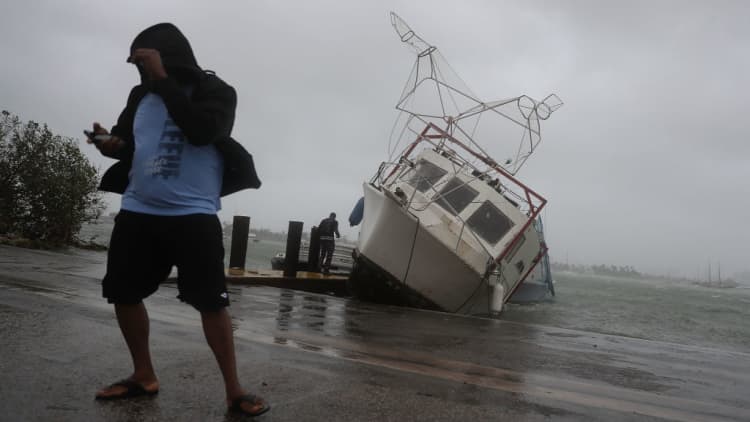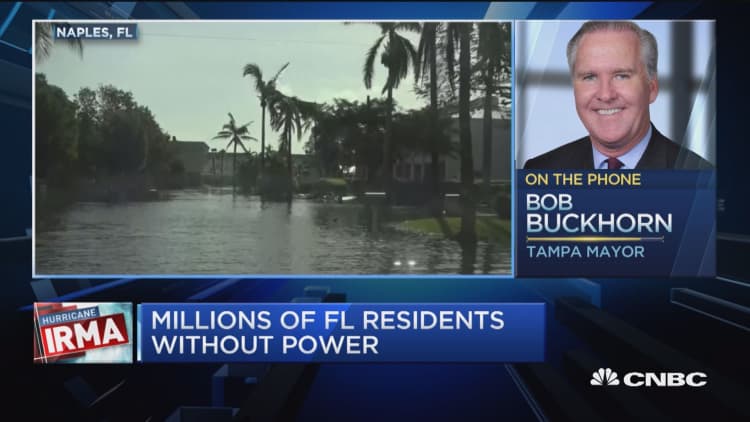
Downgraded from a hurricane to a tropical storm, Irma flooded several northern Florida cities with heavy rain and high storm surge on Monday, while ripping roofs off and cutting power to 6.2 million homes or more than 60 percent of the state.
Electricity company Florida Power & Light said Monday some Florida residents could be without power for weeks.
Irma, once ranked as one of the most powerful hurricanes recorded in the Atlantic, hit a wide swath of Florida over the past day, first making landfall on the Florida Keys archipelago and then coming ashore south of Naples and heading up the west coast.
Now a tropical storm with sustained winds of up to 70 miles per hour, Irma With sustained winds of up to 65 miles per hour, Irma was located about 70 miles east of the Florida state capital Tallahassee and headed toward the Georgia border, the National Hurricane Center said at 11 a.m. ET.
About two dozen vehicles filled with people who had fled the Florida Keys, where Irma roared ashore on Sunday with sustained winds of up to 130 mph, lined up near the entrance to the highway that connects the archipelago to the mainland with a series of bridges and causeways.

They expressed anger at police who asked them to drive to a racetrack a few miles away to register before returning to their homes.
"This is how people are going to die — nobody's going to want to leave the Keys," shouted Shelby Bentley. "I've been in the Keys for 40 years ... It's the first time I've evacuated from a hurricane. It'll be my last time."
Officials in Monroe County, where the Keys are located, said that most of the islands still lacked fuel, electricity, running water and cell service on Monday.
"For many people, supplies are running low and anxiety is running high," the county said in a statement posted online. Inspection teams were working to clear bridges and ensure their safety. "Once the roads are cleared, and the bridges are inspected for use, aid and relief can start to move."
Irma hit Florida after powering through the Caribbean as a rare Category 5 hurricane, the top rung of the Saffir-Simpson scale. It killed 38 people, including 10 in Cuba, which was battered over the weekend by ferocious winds and 36-foot waves.
Northeastern Florida cities including Jacksonville were flooding on Monday, with city sheriffs pulling residents from waist-deep water.
"Stay inside. Go up. Not out," Jacksonville's website warned residents. "There is flooding throughout the city and more rain is expected."
Forecasters had feared the worst for Tampa, but the coastal Florida city was relatively spared.
"When the sun came up, it was a good day," Tampa mayor Bob Buckhorn told CNBC's "Power Lunch." "Because considering what we were facing, this could have been a vastly different scenario both fiscally and otherwise."
Walt Disney World's theme parks and Disney Springs will reopen Tuesday. Disney's water parks will not reopen until later in the week.
HEART-POUNDING NIGHT
After what she called a terrifying night bunkered in her house in St. Petersburg, on Florida's Gulf Coast, with her children and extended family, Julie Hally emerged with relief on Monday. The winds had toppled some large tree branches and part of a fence, but her house was undamaged.
"My heart just pounded out of my chest the whole time," said Hally, 37. "You hear stuff hitting your roof. It honestly sounds like somebody is just whistling at your window the whole night. Its really scary."
Governor Rick Scott said he would travel later on Monday to the Florida Keys. Irma first came ashore at Cudjoe Key as a Category 4 hurricane with sustained winds of up to 130 mph.
President Donald Trump in a ceremony at the Pentagon to remember the victims of the Sept. 11, 2001, attacks vowed a full response to Irma, as well as continued federal support for victims of Hurricane Harvey, which flooded Texas.
"These are storms of catastrophic severity and we are marshaling the full resources of the federal government to help our fellow Americans," Trump said. "When Americans are in need, Americans pull together and we are one country."
The state's largest city, Miami, was spared the brunt of the storm but still saw heavy flooding. Utility crews were already on the streets there clearing downed trees and utility lines. All causeways leading to Miami Beach were closed by police.
As it traveled through the center of the state early on Monday, Irma brought gusts of up to 100 mph and torrential rain to areas around Orlando, one of the most popular areas for tourism in Florida because of its cluster of theme parks, the National Weather Service said.
A piece of a McDonald's "golden arch" sign hung in a tree near the fast-food restaurant in the central Florida city of Kissimmee on Monday morning. Valerie Gilleece, 55, had ridden out the storm in the city because her wheelchair-bound husband insisted on it, she said.
"I'm just thanking God to be alive," Gilleece said. "I wanted to go from the start but he's stubborn as hell."
Over the weekend, Irma claimed its first U.S. fatality - a man found dead in a pickup truck that had crashed into a tree in high winds in the town of Marathon, in the Florida Keys, local officials said.
During its passage through the Caribbean en route to Florida, Irma was ranked at the rare top end of the scale of hurricane intensity, a Category 5, for days. It carried maximum sustained winds of up to 185 mph when it crashed into the island of Barbuda on Wednesday.
Ahead of Irma's arrival, some 6.5 million people in southern Florida, about a third of the state's population, were ordered to evacuate their homes. Some 200,000 were housed in shelters during the storm, according to federal officials.
Delta said it has decided to cancel about 800 flights Monday as Irma tracks toward its Atlanta hub with "strong crosswinds that exceed operating limits on select mainline and regional aircraft." Over the weekend, Irma grounded a greater-than-expected 12,000-plus flights on four continents.
Miami and Tampa international airports, as well as airports in Fort Lauderdale, West Palm Beach, were closed on Monday.
DAMAGE ESTIMATES
The storm did some $20 billion to $40 billion in damage to insured property as it tore through Florida, catastrophe modeling firm AIR Worldwide estimated.
High winds snapped power lines and left about 5.8 million Florida homes and businesses without power, state data showed.
Miami International Airport, one of the busiest in the country, halted passenger flights through at least Monday. According to the FlightAware.com tracking site, a total of 3,582 U.S. flights were canceled on Monday, mostly as a result of the storm.
Irma was forecast to cross the eastern Florida Panhandle and move into southern Georgia later in the day, dumping as much as 16 inches (41 cm) of rain, government forecasters said.
Police in Miami-Dade County said they had made 29 arrests for looting and burglary.
Irma, which hit just days after the Houston area was deluged by unprecedented flooding in Texas from Hurricane Harvey, was expected to cause billions of dollars in damage to the third-most-populous U.S. state.
Investor relief over Irma's weakening on Monday helped boost world shares to a record high on Monday.
LACK OF POWER
Former FEMA Deputy Administrator Rich Serino told CNBC a major concern for Florida officials is people without power. On Monday, Florida power outages totaled more than 6 million, about 60 percent of the total state, and was rising.
Serino, who served between 2009 and 2013, said turning the power back for several Flordia homes will be difficult because there is major damage to The Sunshine State's infrastructure.
"It's not as simple as putting a few wires back up," he said on "Squawk on the Street." "It'll be days, in some cases weeks before people get power back."
Serino, citing reports from electric officials, said it could be one of the largest electric system rebuilds the state's ever had.
Also on the show was Gordon Gillette, Tampa Electric president and CEO. He said 45 percent of his customer were without power as of Monday.
"In term of restoration, we are going to be dispatching our native crews today, about 700. Two hundred additional foreign crews will join them tomorrow," he told CNBC. "We expect a restoration that will take not hours but days. But we don't think weeks."
Tampa Mayor Bob Buckhorn lifted the curfew for the City of Tampa Monday effective at 8 a.m. Residents were urged to use caution when returning to their homes as there may be downed trees, branches, and powerlines.
—CNBC's Berkeley Lovelace Jr. contributed to this report.

